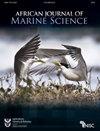使用无人水面船对几内亚湾 o tom和Príncipe的喙鲸分布进行声学调查
IF 1.4
4区 生物学
Q3 MARINE & FRESHWATER BIOLOGY
引用次数: 0
摘要
第一批喙鲸的记录,包括居维叶喙鲸Ziphius cavirostris,是在西非几内亚湾的本文章由计算机程序翻译,如有差异,请以英文原文为准。
An acoustic survey of beaked whale distribution at São Tomé and Príncipe, Gulf of Guinea, using an unmanned surface vessel
The first records of beaked whales, including Cuvier’s beaked whale Ziphius cavirostris, are reported from an acoustic baseline survey in the territorial waters of the Democratic Republic of São Tomé and Príncipe, Gulf of Guinea, West Africa. The survey was carried out between late 2018 and early 2019 using an AutoNaut unmanned surface vessel (USV), which is propelled by the motion of waves and operated remotely via a satellite link. The USV towed a hydrophone array on a cable, and over the course of 75 days the USV completed 1 772 km of acoustic survey effort. Beaked whale encounters were not uncommon and occurred on 28 of the 75 survey days. They were widespread on the shelf edge and in oceanic habitats above the abyssal plain. The average water depth at which acoustic detections were recorded was 2 519 (SD 555) m (n = 43). Beaked whales were evenly distributed across areas with different seabed characteristics: the number of encounters recorded in areas characterised by seabed gradient and ruggedness did not differ from that expected after accounting for survey effort. The majority of acoustic detections were attributable to Cuvier’s beaked whales, based on spectral and temporal characteristics of click-train vocalisations. The results provide baseline information on the distribution of beaked whales and suggest that passive acoustic methods using a small USV are well-suited to surveys of this species group, possibly because beaked whales, which are sensitive to disturbance associated with underwater sound sources, are less likely to avoid small, quiet vessels than larger vessels.
求助全文
通过发布文献求助,成功后即可免费获取论文全文。
去求助
来源期刊

African Journal of Marine Science
生物-海洋与淡水生物学
CiteScore
2.60
自引率
16.70%
发文量
17
审稿时长
6-12 weeks
期刊介绍:
The African (formerly South African) Journal of Marine Science provides an international forum for the publication of original scientific contributions or critical reviews, involving oceanic, shelf or estuarine waters, inclusive of oceanography, studies of organisms and their habitats, and aquaculture. Papers on the conservation and management of living resources, relevant social science and governance, or new techniques, are all welcomed, as are those that integrate different disciplines. Priority will be given to rigorous, question-driven research, rather than descriptive research. Contributions from African waters, including the Southern Ocean, are particularly encouraged, although not to the exclusion of those from elsewhere that have relevance to the African context. Submissions may take the form of a paper or a short communication. The journal aims to achieve a balanced representation of subject areas but also publishes proceedings of symposia in dedicated issues, as well as guest-edited suites on thematic topics in regular issues.
 求助内容:
求助内容: 应助结果提醒方式:
应助结果提醒方式:


